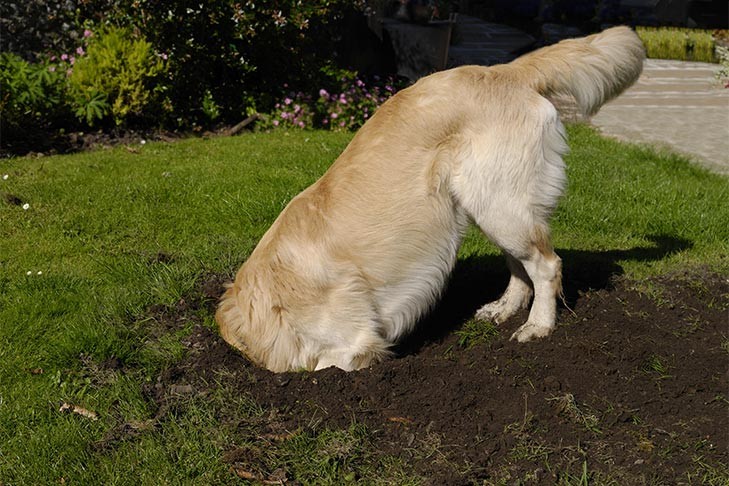Have you ever watched your furry friend meticulously bury their favorite bone or toy in the backyard, under a pile of blankets, or even in the couch cushions? This common canine behavior often leaves owners puzzled and sometimes frustrated, especially when prized possessions disappear into the earth. So, Why Do Dogs Bury Bones and other treasured items? The answer lies deep in their ancestry and instinctual drives.
Ancestral Instincts: A Pantry for Hard Times
To truly understand why dogs bury bones, we need to look back at their wild ancestors, including wolves and wild dogs. These animals lived in an environment of “feast or famine.” In the wild, meals weren’t guaranteed daily. When a hunt was successful, these canines would gorge themselves, consuming as much as possible because they didn’t know when their next meal would come. This survival strategy also included preserving any leftover food.
Burying meat was a clever way to keep it safe and fresh for later consumption. The cool earth acted as a natural refrigerator, shielding the meat from the sun and reducing the chances of spoilage. This buried stash essentially became a hidden pantry, a valuable resource to return to when food was scarce. Imagine it as a wolf’s prehistoric refrigerator, ensuring sustenance during lean times.
The Lingering Instinct in Modern Dogs
Even though your pampered Dachshund or playful Labrador Retriever enjoys regular meals and a comfortable life, the instinct to bury is deeply ingrained. Domestication has provided dogs with consistent food sources, but it hasn’t erased millions of years of evolutionary programming. Burying behavior is a vestige of their wild ancestry, a natural inclination that persists even when it’s no longer necessary for survival.
Just like other instinctive behaviors such as herding, hunting, or retrieving, burying is part of a dog’s inherent repertoire. Some dogs exhibit this behavior more prominently than others, and it’s often observed more frequently in certain breeds, particularly those with strong hunting backgrounds.
Breed Predisposition: Hunting Breeds and Burying
Interestingly, owners of hunting dog breeds, such as Terriers, Beagles, and Retrievers, often report witnessing burying behavior more often than owners of herding or non-sporting breeds. This observation makes sense when considering the link between hunting and resource saving.
Dogs bred for hunting possess a heightened drive to secure and conserve resources, a trait that directly aligns with the instinct to bury. For these breeds, burying may be an amplified expression of their natural hunting instincts, a way to safeguard their “prey” – whether it’s a bone, toy, or treat – for future enjoyment.
 Golden Retriever enthusiastically digging in the yard, showcasing a common dog burying behavior rooted in instinct.
Golden Retriever enthusiastically digging in the yard, showcasing a common dog burying behavior rooted in instinct.
Managing the Burying Behavior: Redirecting the Instinct
Understanding that burying is an instinctual behavior, not a sign of disobedience, is the first step in managing it. If your dog’s burying habits are turning your garden into a minefield, there are constructive ways to redirect this natural urge.
One effective strategy is to reduce the surplus of resources available to your dog. If your dog is burying toys frequently, try offering only a couple of toys at a time. Rotating toys weekly can also keep them engaging and prevent your dog from feeling overwhelmed with possessions to hide. Similarly, avoid giving bones or high-value treats immediately after meals when your dog is already satiated.
Turning Burying into a Game or Providing a Designated Digging Area
For dogs who genuinely enjoy the act of burying, you can channel this enthusiasm into positive outlets. Turn burying into a fun game by teaching your dog to “bury” a toy or bone on command in a designated area like a pile of blankets or pillows indoors. You can then make it even more engaging by adding a “find it” cue for retrieval. This transforms the burying instinct into an interactive game that both you and your dog can enjoy without landscape damage.
If you have the space outdoors, consider creating a designated digging box or area filled with loose dirt or sand. This provides your dog with an appropriate space to indulge their burying desires to their heart’s content, keeping them away from your prized flowerbeds and garden.
Conclusion: Embracing Natural Instincts
In conclusion, the behavior of dogs burying bones and other items is a fascinating glimpse into their evolutionary past. It’s a testament to the enduring power of instinct, a behavior that has persisted through domestication and remains a natural part of canine behavior.
By understanding the “why” behind this behavior, we can better appreciate our dogs’ innate drives and find constructive ways to manage and even enrich their lives. Providing outlets for these instincts, whether through games or designated digging areas, allows dogs to express their natural behaviors in a way that is both satisfying for them and manageable for us. And who knows, maybe understanding their burying habits will help you locate your missing TV remote one day!